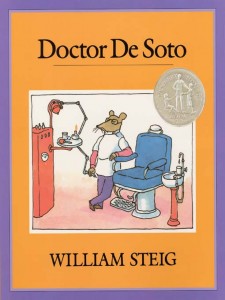

A Fantastic and Classic Couple of Mice Featured as a Grand Husband and Wife Team That Outfox a Fox Who is Fetid!
Dr. De Soto
by William Steig
It’s no secret that I love classic children’s picture books and today I’m featuring perhaps the most favored, in my mind, of a highly favored group. There are picture book writers who can weave an imaginary tale full of wry wit and wisdom, coupled with wonderful illustrations. In case you’re wondering whom I’m referring to, his name is William Steig.
The beauty of Mr. Steig’s books, whether it be Dr. De Soto, (Caldecott Winner), The Amazing Bone, Amos and Boris, or Sylvester and the Magic Pebble (Caldecott Winner), is that never in these books does he talk down to kids, but instead has always respected their imaginations and intelligence with his use of complex vocabulary and sentence structure, littering his stories with words like “fetlock”, “fusty”, “fens”, “churlish”, “knaves”, “odoriferous”, “ravenous” and “bicuspid”.
Somehow Steig understood that kids would get the meaning of these words in the context of his stories. His books are filled with bones that talk, magic pebbles, unlikely friendships between mouse and whale, ogres and ogresses with deeps secrets of beauty that is skin deep, and dentists who treat animals that are their natural predators.
He’s proof positive (and late bloomers who want to segue into another profession, take note), that it’s never too late to follow your dreams or reinvent yourself.
William Steig, cartoonist for The New Yorker, didn’t start his foray into picture books until his 60’s, but once he started, he unleashed a treasure trove of books that resonated with generations of children. Our classic picture book today is called Dr. De Soto and it is penned by the inimitable William Steig of whom I spoke.
As The Philadelphia Enquirer said with unrestrained glee in referring to this book, “ This is one of those picture books that are so good, I’d just like to quote the whole thing.” Me too! But maybe just a bit, for William Steig is a national treasure for the picture book lover. Here, in Dr. De Soto, he richly creates a mood, characters and a story that stays through many readings.
First the plot. Dr. De Soto a kindly mouse/dentist cannot resist animals large or small in pain be they friend or foe. He’s both compassionate and competent in the extreme. But when a whimpering but wily fox shows up with a fetid molar that needs extraction, does he listen to his head or heart? What do you think? How can he treat and not be “treated as meal” especially when under anesthesia his patient tips his hand.
“I’m giving you gas now” said Dr. De Soto. “You won’t feel a thing when
I yank that tooth.” Soon the fox was in dreamland. “M-m-m, yummy,”
he mumbled. “How I love them raw…with just a pinch of salt, and a…dry…
white wine.”
An ethical dilemma ensues for the compassionate but weary Dr. De Soto. But this is no ordinary mouse-dentist, folks. He and his wife/assistant come up with a “solution”, literally that is fair turnabout to this finagling fox, yet does involve entering the foxes’ mouth! Huh? Your kids will love Dr. De Soto and mate, and pity (well, maybe a little), this dandified sufferer who, dressed to the nines with cravat, waistcoat and walking stick in hand awaiting his final appointment – and “lunch,” is “outfoxed”.
William Steig is a must read for anyone who loves kids and picture books. He is the real deal with the entire talent package of wondrous stories, amazing plots with twists and clever pictures, all combined to perfection.
Yum! Read it again!
*******************************************
You may have noticed that many of the books that I select are Caldecott Award winning books. You may or may not know that the Caldecott medal is given yearly to “the most distinguished picture book for children published in the United States beginning with 1937 publications.” It is awarded to the illustrator by The Association for Library Service to Children- a division of the American Library Association. The award is named for Randolph Caldecott, a 19th century English illustrator, and here are the criteria for the award:
- The book must be published in English in the United States during the preceding year
- The illustrations must be original work
- The artist must be a citizen or resident of the United States
- The book must be considered for the artistic technique employed, pictorial interpretation of story, appropriateness of style of illustration to the story, delineation of plot, theme, characters, setting, mood or information through the pictures and recognition of a child audience
- The book must display respect for children’s understandings, abilities and appreciations.
- The book must be a self-contained entity, not dependent on other media for its enjoyment.
The reason I so often select Caldecott winners for blog entries or videos is because I feel that these stories have stood the test of time. And time is the great leveler. I feel they have something in their themes that still speak to consecutive generations, even though some of them were written many years ago. They may have fallen off the radar for many parents or grandparents who remember reading them in their youth and so one of my goals is to bring them front and center again for a new batch of readers to enjoy.
